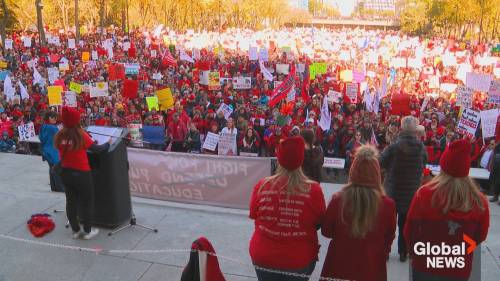Thousands of educators descended upon the Alberta Legislature steps Wednesday, their voices echoing across Edmonton’s downtown core in what many observers call the largest teacher mobilization in recent provincial history. The rally marks a critical escalation in the ongoing dispute between Alberta’s 46,000 teachers and the United Conservative Party government over classroom conditions and bargaining rights.
“We’re not just fighting for better wages,” said Melissa Purcell, a 15-year veteran teacher from Calgary, as wind whipped through the crowd of placard-bearing educators. “We’re standing for the future of education in this province. Our classrooms are overflowing, resources are stretched thin, and this government continues to ignore the realities we face every day.”
The Alberta Teachers’ Association (ATA) organized the massive demonstration following months of stalled negotiations with the provincial government. Teachers are demanding smaller class sizes, increased support for students with complex needs, and restoration of collective bargaining rights that were stripped away through controversial legislation in 2020.
Education Minister Adriana LaGrange responded to the rally in a written statement, defending the government’s position that Alberta teachers remain among the highest-paid in Canada. “We’ve increased education funding by over $700 million since taking office, and we remain committed to working with teachers to ensure Alberta students receive world-class education,” LaGrange stated.
However, ATA President Jason Schilling challenged this narrative during his impassioned address to the crowd. “This isn’t about compensation—it’s about respect and recognition of the increasingly difficult conditions teachers face,” Schilling declared. “When we have classrooms with 35+ students, including several with complex needs, and no additional supports, how can we possibly provide the quality education our students deserve?”
The strike action has garnered significant support from parents and community members. Recent polling indicates that 62% of Albertans believe teachers’ concerns about classroom conditions are legitimate, according to data from an independent research firm.
“I’m standing with our teachers because I’ve seen firsthand how overwhelmed they are,” said Patricia Norris, a parent of three school-aged children who attended the rally. “My son’s Grade 4 class has 33 students with one teacher. That’s not sustainable or effective.”
The dispute occurs against the backdrop of broader public sector tensions in Alberta, with healthcare workers and other public employees expressing similar frustrations with government policies. Economic analysts suggest this convergence of labor unrest could present significant challenges for Premier Jason Kenney’s administration as it navigates post-pandemic recovery in a province historically sensitive to economic disruption.
If no resolution is reached, the ATA has indicated that rotating strikes could begin as early as next week, potentially affecting schools across the province. School boards are already developing contingency plans, though officials acknowledge that extended job action would create substantial difficulties for families.
As the sea of red-clad teachers dispersed from the Legislature grounds Wednesday afternoon, the question hanging in the crisp Alberta air was not if, but how far both sides are willing to go in a standoff that places the province’s education system—and ultimately its children—in the crossfire of an increasingly bitter political dispute.










